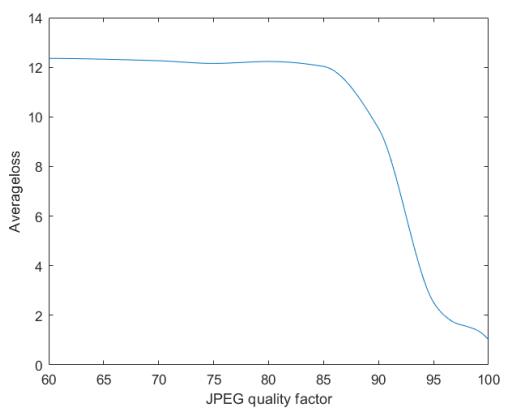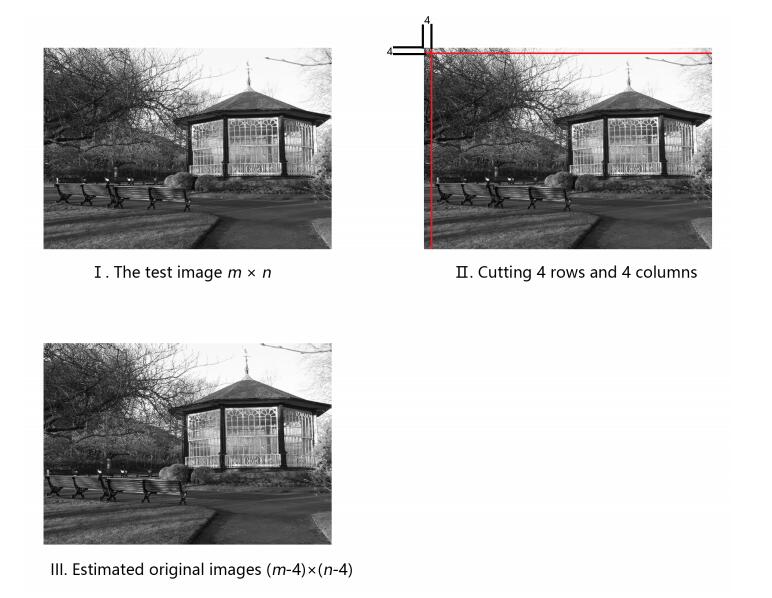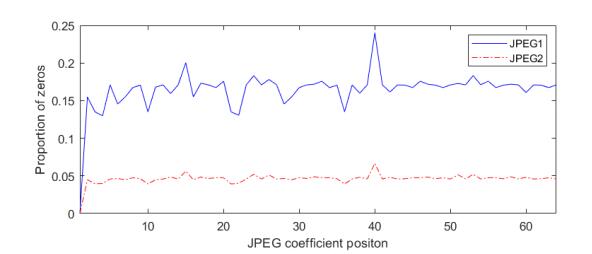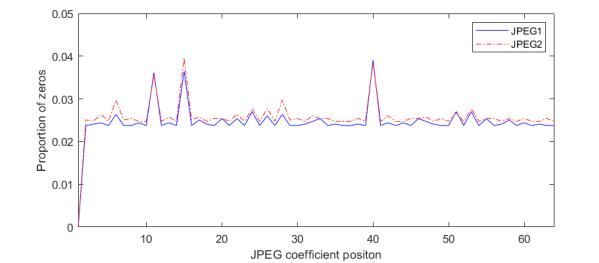The authenticity of the image is crucial to many cases. The efficient detection of the JPEG compression history of bitmap image could reveal the possibility of tampering on the image. In this paper, we propose a lightweight but reliable JPEG compression detection method based on image information loss. An efficient feature of the decreasing percentage of zero coefficient is proposed to detect the JPEG compression history of an image, due to the increasing JPEG compression quality factor. In our method, estimated original images are first created. Then the given image and its estimated counterpart are compressed to get the JPEG coefficient. After that, the image information loss will be calculated. Through the analysis, the goal of the compression history detection can be achieved. Extensive experimental results have demonstrated that the proposed method outperforms the existing methods.
1.
Introduction
Infectious disease, in recent times, is a great concern in public health. Around the world, microbial infection causes mortality in millions of people every year [1]–[4]. Further, the microbes can turn resistant to antibiotics due to their high mutative capacity and morphological changes [5]–[7]. A nanoparticle (NP)-based treatment approach could be promising to overcome the drug-resistant effects of the microbes. Further, NPs can have innate antimicrobial activities [8],[9]. NPs can generate reactive oxygen species (ROS), which can damage DNA and proteins and block the growth of bacteria, fungi and viruses. Antibiotics conjugated with nanoparticles have therefore been thought to be an efficient antimicrobial regimen [10]. The antibiotic cefaclor attached to gold nanoparticles (52–22 nm) showed significant antibacterial activity [11],[12]. Biogenic selenium nanoparticles have anti-biofilm activity and effectively retard the growth of Pseudomonas aeruginosa, a Gram-negative bacteria [13],[14]. Similarly, TiO2 nanoparticles have been found to inhibit the formation of fungal biofilms [15].
Nanotechnology can help the world's medical community to fight against virus infection also [16],[17]. For example, studies have been done successfully on the effects of nano-materials as antivirals against the virus SARS-CoV-2, inhibiting its entry into cells, its RNA replication and, finally, its release [18]–[20]. In addition, nano-materials provide a wide range of opportunities for diagnosis, treatment and in controlling the biofilm formation. Recent advances of applications of various nanomaterials in the diagnosis and treatments of microbial infections have been reviewed elsewhere [21]–[24]. However, their impact on human tissues and the environment should be assessed before implementations in large-scale industry are carried out [25].
Here, we discuss several aspects of using nanoparticles in infectious diseases, their pros and cons, challenges for nanoparticles and future prospects.
2.
Nanoparticles/Nanocomposites and their antimicrobial properties
Nanoparticles (NPs) belong to a group of substances having diameters ranging from 1–100 nm [26]–[29], and they possess the ability to penetrate the bacterial cell wall, which is made up of peptidoglycan. NPs can dismantle the peptidoglycan layer from Gram-positive bacteria and also overcome antimicrobial resistance [5],[30],[31],
2.1. NPs and their antibacterial activities (Table 1)
2.2. NPs as an antiviral regimen (Table 2)
Viruses can infect prokaryotes as well as eukaryotes. Vaccines are effective in some of viral diseases such as smallpox, polio, etc, yet further opportunities to overcome antiviral drug resistance is possible by using NPs [39],[40].
2.3. Application of NPs in fungal and parasite infections (Tables 3 and 4)
Some industrial and biomedical applications of nano-materials as alternatives to commercially available antibiotics and anti-fungal medications are reviewed in [22],[24] (Tables 5 and 6).
3.
Nanoparticles (NPs) and their biological compatibility (Table 7)
When NPs come into contact with blood, they may initiate some biological effects, which could be good or bad. Hence, it is important to determine the blood-NPs compatibility before they can be used in humans [74],[75]. A few observations are the following:
-
The blood-NPs compatibility depends on the size, structure and formulation of the NPs [74],[76].
-
Biopolymeric NPs have been found compatible when used in the treatment of asthma, tuberculosis and lung cancer [77],[78].
4.
Nanoparticles (NPs): Encapsulation and biodegradability
Since the accumulation of nanoparticles in the spleen and liver may turn out as toxic, biodegradable NPs (BNPs) should be more appropriate than non-degradable NPs [97]. Other significant factors are the following:
-
Nanopolymers are biodegradable and can encapsulate other therapeutic regimens to deliver them to the action site [98].
-
Polysaccharides, proteins and some synthetic polymers are the main sources of BNPs.
-
Polymersomes (or polymer vesicles) can be used for drug delivery as their coronas and membranes can be modified for biomedical active different groups. Polymersomes are very suitable drug deliver agent for bacterial infection, and cancer therapy, as well.
-
Antibacterial polymersomes are divided into three categories:
-
polymersomes as antibiotic nanocarriers,
-
intrinsically antibacterial polymersomes and
-
antibacterial polymersomes with supplementary means, including photothermal and photodynamic therapy.
-
Similarly, the anticancer polymersomes are divided into two categories:
-
Polymersome-based delivery systems, and
-
Anticancer polymersomes with supplementary means.
In this review, the prospective antibacterial and anticancer polymersomes are discussed.
4.1. Selection of polymers and the synthesis of BNPs
The end application is the main criterion for the selection of the polymer, but their size, bio-compatibility, biodegradability and the capability of encapsulation of the drug materials are similarly important factors to be considered [99]. Some of the different biodegradable polymers and their merits for use as BNPs are listed in Table 8.
5.
Nanoparticles-mediated microbial targeting strategies
NPs may be considered by the human body as a foreign particle, so macrophages / phagocytic cells can remove them from blood circulation. Therefore, the surfaces of NPs should be modified to allow them to bypass the immune system of the body [105], so they can stay in the vascular system for a longer period of time and may reach their target safely [106]. PEGylation of NPs results in less interaction with phagocytes and being sustained longer in the circulation system [107]. Similarly, tocopherol PEG-1000 succinate can modify NPs, which then in turn exhibit increased adhesion towards tumor cell surfaces [108],[109].
The conventional methods of drug delivery have several limitations, such as poor biodistribution, lack of selectivity and limited effectiveness [110],[111]. Attachment of NPs to the therapeutic drug can make possible site-specific delivery and can reduce any undesirable side effects [112],[113]. Representative clinical trials with small molecule-based targeting have been tabulated elsewhere [114],[115].
5.1. Evidence for the attachment of NPs to therapeutic drugs for site-specific delivery
The use of nanotechnology in medicine is mostly for targeted drug delivery and also to reduce toxicity and side effects of the drugs. Until recently, it was not realized that these carrier systems themselves may cause risks to the patient. Therefore, a conceptual understanding of biological responses to nanomaterials is needed to develop [116]–[123].
6.
Limitations
-
The major concern is to maintain the proper size and shape of mono-dispersed NPs with stability during synthesis [124].
-
NPs may accumulate in different bio-organs, which may cause problems in normal biological function in the future [125].
-
Since NPs may escape the immune challenge of the body, they may cause some sort of inflammation or toxicity [126].
-
NPs can generate ROS, which are major contributors of inflammation, oxidative stress and apoptosis [127].
-
Still, there are many other disadvantages in using NPs. For example, toxicity, environmental harm and organ damage may be caused by nanoparticles [128].
-
Nanoparticles, after a threshold limit, may be toxic in nature and have to be degraded chemically.
-
Some identified toxic mechanisms are through the production of ROS, which is cytotoxic, genotoxic, and neurotoxic, also. Those toxic effects of nanoparticles' depends on its type, size, surface area, shape, aspect ratio, surface coating, crystallinity, dissolution and agglomeration properties. Therefore, it is important to consider of any toxic effects of nanoparticles when it is being synthesized [129],[130].
6.1. Limited availability and side effects
It has already been demonstrated that many nanoparticles in lab rats have resulted in lung inflammation and blood clotting, and in the human body they could trigger unwanted reactions like damage to cells and organs [131].
-
Nanoparticles produce ROS and oxidative stress, which may cause neurodegenerative diseases such as Alzheimer's and Parkinson's diseases [132].
-
Uptake of the nanoparticles through the olfactory epithelium can also take place, leading to epithelial cell injury, which can compromise the basic functions of the nose [133].
-
Silica exposure causes oxidative stress. At high doses, silica induces membrane damage and cytotoxicity [134].
-
Another limitation of using nanotechnology in medicine is its high expense. The use of nanomedicine would increase the cost of health care, which would make its access difficult for the poor [135]. Furthermore, the ethical, social and legal facets of nanomedicine need to be handled tactfully to gain civic backing. Though efforts are being made to increase the understanding of using nanomedicine in living beings, there is still ambiguity surrounding the risks that humans would be exposed to with its use. As a result, the clinical trials involving nanomedicine pose distinctive challenges. The leading ethical issues encompass assessing, managing and communicating the risk during clinical trials. To evade the possibility of public criticism, it becomes imperative to educate the people about the benefits and pitfalls of nanomedicine [136].
7.
Nanoviricide (NV-387)
A new antiviral regimen could emerge as an antimicrobial. NV-387 is a self-assembling, uniform and tailorable linear homopolymer designed and designated as a TheraCour platform polymer. Here, the monomer is functionalized by attaching polyethylene glycol (PEG) connected covalently with a site-targeting ligand [137] (Figure 1).
This binding results in avidity and that force leads to passive fusion of the virus. Further, being encapsulated, the loaded drug can be released from the polymer backbone in a covalent system immediately [19],[138],[139], TheraCour platform polymer (NV-387) adds further advantages providing an extreme level of tailorability, also:
(A) Different ligands can be chosen for different targets.
(B) By changing the appropriate lipid length and balancing the PEG-monomer chain length, one can balance the hydrophobic/hydrophilic balance of the PEG Polymer. The longer lipid chain would be more suitable for dermal delivery of the drug as a cream or ointment. In contrast, short lipid chains would result more hydrophilic in nature and merely assist in conformational stability and adherence to the cell membrane.
(C) The rate of release of the API can be modified by tailoring the connector, like pH-sensing, or esterase or protease-specific functions, etc.
(D) The polymerization can be controlled within the limits (Flory equation), to provide a desirable clearance characteristics.
NV-387 is a non-crystalline semi-solid, off-white, waxy in texture material (at room temperature). It's theoretical molecular formula is C104H188N2O44S4. The calculated formula weight of the polymer repeat unit (RU) is 2298.85 g/mol. The degree of polymerization, “n”, in P10M2DT (HDA)x (MMSA)y polymer is 8 ± 2 [19]. Pharmaceutical properties, formulations for injection, physical properties, and chemical properties are all available elsewhere [19].
7.1. Chemical charateristics of TheraCour biopolymer NV387
NV-387 is a non-crystalline semi-solid, off-white, waxy in texture material (at room temperature). It's theoretical molecular formula is C104H188N2O44S4. The calculated formula weight of the polymer repeat unit (RU) is 2298.85 g/mol. The degree of polymerization, “n”, in P10M2DT (HDA)x (MMSA)y polymer is 8 ± 2 [19].
Pharmaceutical properties, formulations for injection, physical properties, and chemical properties are all available elsewhere [19].
These materials have been shown to be capable of (a) site-directed (address-based) cell or virus targeting, (b) protective active pharmaceutical ingredient (API) encapsulation, (c) direct delivery of such encapsulated APIs into the address-specified cell or virus, (d) tailorable circulation lifetime and (e) sustained delivery characteristics, while at the same time being biocompatibility, non-toxic, non-immunogenic, and biodegradable [137].
7.2. Antiviral activity of TheraCour polymer, NV387:
In viral diseases, TheraCour platform based nanopolymer, NV-387, is noticeable. The therapeutic principle of NV-387 is based on its unique structure. As we know that the virus envelope carry a lipid membrane derived from the host cell membrane, the TheraCour polymer can attack viruses. Interestingly, no active API is required in this scenario if the ligand is properly chosen for making the biopolymer. Once the virus is attached by the micelle carrying ligands, lipid-lipid mixing essentially pulls the lipid membrane of the virus to the site of the attack and the virus gets dispersed, resulting a naked virus capsid that cannot infect cells (Figure 2) [139]–[143].
7.3. Nanoviricide polymeric micelle works against SARS-CoV-2
This model is the most advanced in the antiviral field. In particular, a drug, targeting for SARS-CoV-2 virus, NV-CoV-2 has completed preclinical studies including GLP Safety/Toxicology and is expected to enter human clinical trials soon. Another derivative, NV-CoV-2-R that encapsulates remdesivir within the core of NV-CoV-2 has shown effectiveness significantly surpassing that of the standard remdesivir formulation, which correlates with significantly improved pharmacokinetics of remdesivir in vivo in animal model studies. Some uses of TheraCour polymer are the entire drug use chain are shown in Tables 9 and 10.
SARS-CoV-2 belongs to a β-family of human coronavirus, which causes the severe lower tract infectious disease called COVID-19 [144]. Throughout the world this pandemic disease virus once evolved in November 2019 is continuously mutating to a new form and infecting people till date. The newer variants (Omicron BA.2) possess greater transmissibility with R0 as 12 [145].
The once effective drugs against SARS-CoV-2, like remdesivir (Gilead), molnupiravir (Merck), and Paxlovid™ (Pfizer) turnout with significant limitations in humans. Molnupiravir is reported as mutagenic and further has poor efficacy. Paxlovid is virostatic and the virus rebounds once the drug is withdrawn. Remdesivir is highly effective in vitro studies, however, in vivo, its efficacy is not satisfactory at all. This may be due to the instability of Remdesivir in the body circulation system [146],[147].
NV-387 is highly effective in cell cultures against coronavirus hCoV-NL63 which like SARS-CoV-2, binds to the ACE2 cell receptor [140]. hCoV-229E that binds to a different cellular receptor, Aminopeptidase N (APN), also can be inhibited by NV-387, indicating itself as a broad-spectrum anti-coronavirus nanopolymer [20],[147],[148].
7.4. Encapsulation of the virus leads to its disintegration
The mechanism of nanoviricide's function is shown through electron photomicrographs (Figure 3). In this study, the murine cytomegalovirus (MCMV) was incubated with a nanoviricide containing sialic acid as a ligand. The light area at top right corner in Figure 3-II indicates that the lipid coat was deformed due to the binding of nanoviricide micelle in that area. The loss of the viral envelope results the lack of viral glycoproteins required for cellular entry and thus becomes non-infectious. Figure 3-III shows that only virion capsids remain as a result of the attack. We have demonstrated a convincing success of our drug NV-CoV-2-R which is an encapsulated remdesivir into the polymeric micelle (NV-CoV-2), in inhibiting the virus growth in animal models [139],[142].
7.5. Safety Studies of NV-387, and NV-CoV-2
NV-387 is a TheraCour biopolymer (API) which on formulation was converted to a drug product against corona virus, and designated as NV-CoV-2. Safety studies on NV-387/NV-CoV-2 indicate that:
-
No abnormal respiratory function or in neurobehavioral aspects were notices in all doses of the test compounds was observed in a rat model.
-
No change in body temperature after the i.v. administration of NV-CoV-2 in rats.
-
Heart rate, blood pressure, cardiac rhythm, and ECG parameters of cynomolgus monkeys were noticed normal after i.v. administration of NV-CoV-2 in them [19].
-
Additionally, NV-387/NV-CoV-2, both were non-immunogenic, non-mutagenic, and non-genotoxic in a rat model.
8.
Discussion and conclusions
The use of nanomaterials has been increasing, with concerns about drug-nanomaterial stability, biocompatibility and biodegradability; and there is interest in control and tailored payload release of the drug, without any side effects, and improving patient compliance [149],[150]. With these concerns, recently, nucleic acid-based cross-linkers, as they are able to self-assemble into a stable 3-dimensional structures, have gained much attention [149]–[151]. In addition, nucleic acids can act as a targeting agent through engineered aptamer and drug payload carriers. They also have shown the ability to control the release of proteins [152]–[155]. Owing to these versatile characteristics, it is expected that nucleic acid-based hydrogels will be an important regimen in the future for targeted drug release.
Treatment of infectious disease with antibiotics becomes a challenge when the organisms evolve drug resistance. Therefore, discovery of methods of treatment and/or therapeutic regimen warrants great priority. Nanotechnology offers an innovative advance in NP-based bio-imaging, which can be used for early detection, diagnosis and treatment of many diseases, especially those that are caused by drug-resistant microorganisms. Nanoparticles have been shown, due to their unique size, shape, charge and surface area, to possess unique activity against different microbial infections. In addition, NPs find their other uses in drug delivery, gene delivery and targeted therapy of various diseases including cancer.
The development of nanotechnology for the synthesis of NPs/nanocomposites can be used to treat various diseases which are difficult to treat with the conventional approaches. However, the limitations and health risks that are associated with these nano-sized particles should not be ignored. Nowadays, in many cases, nanotherapy along with the conventional antibiotic therapy is used to overcome microbial resistance. NPs/nanocomposites may resolve difficulties in managing complicated diseases. However, safety and efficacy issues of NPs are now the main concern before their use in humans.









 DownLoad:
DownLoad:











